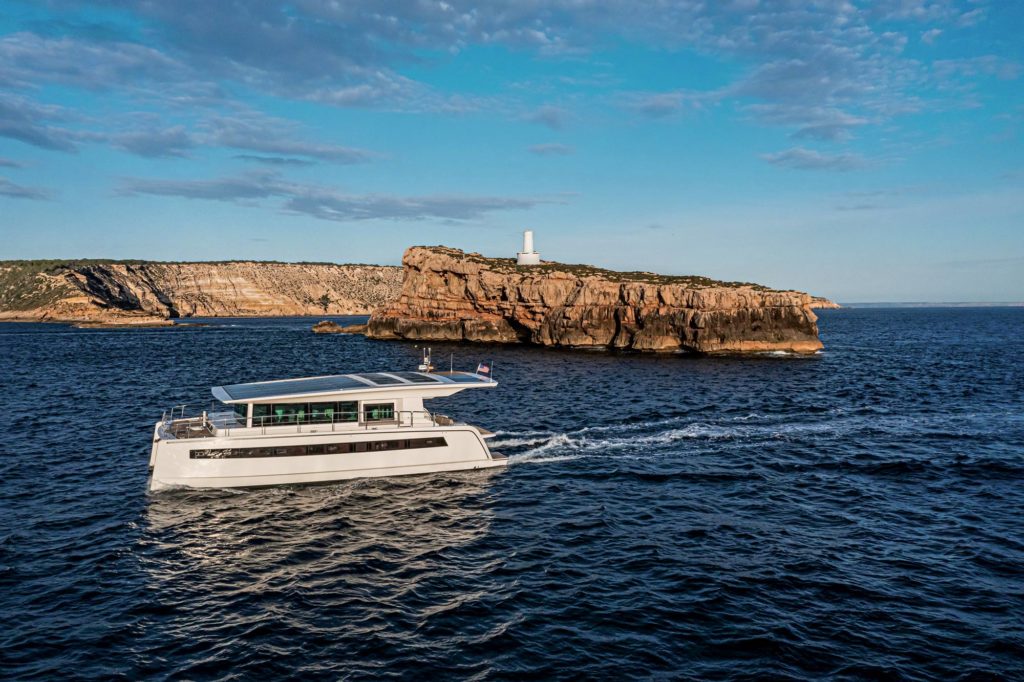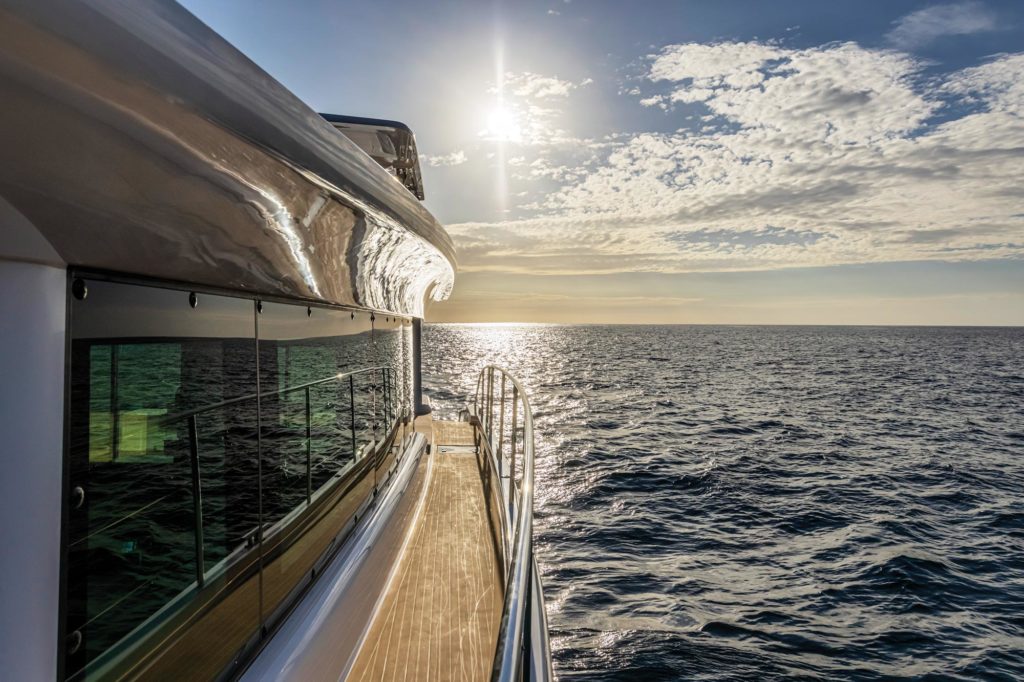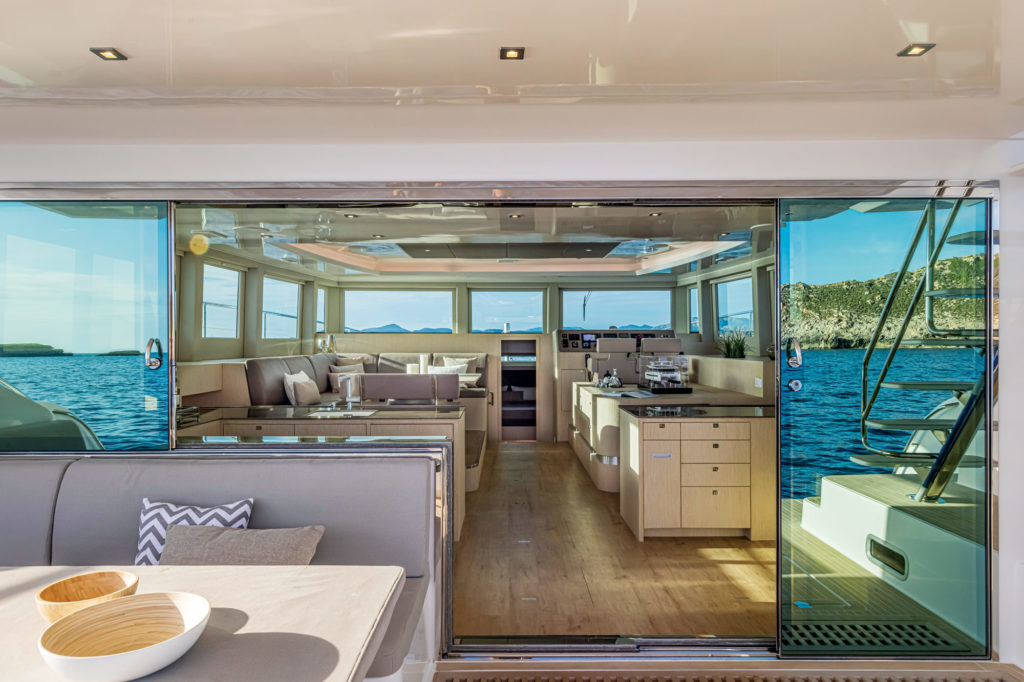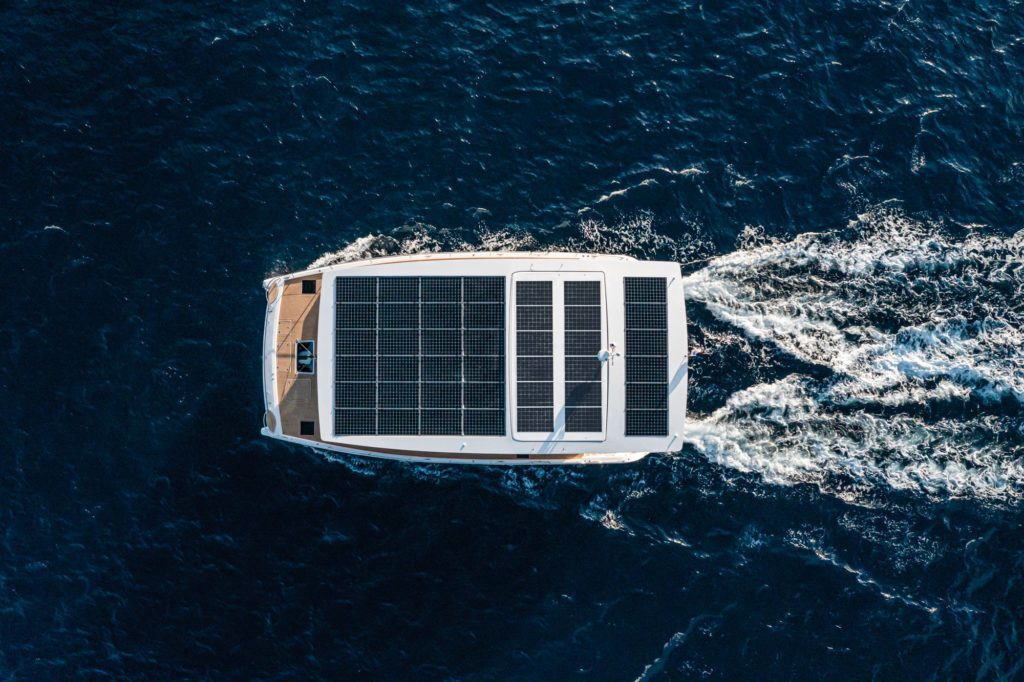
If there was any question that the “Tesla moment” has arrived in yachting, the Silent 60 clearly provides a positive response.
Consider, for a moment, crossing oceans in silence at 5 to 6 knots without consuming a drop of fuel and never needing to plan your course between fuel stops. Imagine sitting at anchor and running the air conditioning all night, not to mention all the galley appliances plus the washer-dryer, without the hum or fumes from a genset.
During my time aboard the Silent-Yachts 60, the electric yacht cruised easily at 8 knots. When I whipped out my sound meter, it barely registered 52 decibels, which is about the sound of a dishwasher. The Silent monitors at the helm showed we were charging our 286 kWh lithium batteries at more wattage than we were using to spin the 340 kW motors, so we were ahead of the power-usage game—and this was in South Florida rain under a solid cloud layer. Had we upped the ante to the yacht’s top speed of 20 knots, it would have been drawing from rather than adding to the batteries, but the speed capability gives skippers the option to outrun weather (or just get to the best moorings first).
The Silent 60 is a catamaran design for several reasons. First, the twin hulls are easily driven to minimize the power needed. Second, with nearly 30 feet of beam, there is enough deck area for the solar panels needed to create power.
Buyers can choose as many as six staterooms, each en suite with stall showers and nearly king-size berths. The salon also uses that beam well, providing bowling-alley space under 7-foot-6-inch headroom. With the Silent 60, the interior is basically a blank sheet, allowing buyers to tailor the layout to their cruising needs.

As for the engine rooms, NASA could take a page from Silent-Yachts: Everything is precisely labeled, placed for easy access and surgery-suite spotless. Externally, the Silent 60 is striking, with reversed bows and black graphic slashes on the topside that conceal dark-tinted windows (which provide bright, airy interiors to the staterooms). What catches the eye most, however, are the 42 solar panels that cover every inch of the cabin top as well as the hardtop over the flybridge. Produced by SunPower in California, these panels feed power to a lithium battery pack reportedly good for 3,000 charge cycles—or an estimated 35 years of normal boating use.
The Silent 60 I got aboard, which was Hull No. 3, had a four-stateroom layout. A larger stateroom forward in the starboard hull served as the master, with an athwartships berth, settee and built-in vanity. This yacht also had a walk-through Dutch door forward in the salon next to the helm, leading to settees on the foredeck as well as providing salon ventilation. Another benefit of the door for short-handed cruisers is quick access to the anchor gear under the foredeck.
Owners can sacrifice the forward door in favor of a forward master stateroom with a king berth just a couple of steps below the salon and an en suite head in the starboard hull. An intriguing design feature is the two outward-facing “window seats” indented into the stateroom on each side deck, which would make a wonderful spot at anchor with a good book.
The salon has a fixed dining table that easily seats eight people on the wraparound settee. There also are loose chairs and a pad just forward for lounging. The helm is raised one step and has twin Simrad multifunction displays plus the Silent systems monitor, all easily understood.

Aft and to port, the U-shaped galley has a dishwasher as well as a full-height fridge to starboard. The fridge setup may change to a pair of undercounter drawer fridges on future boats for easier access and to eliminate a blind spot for the skipper.
Abaft the galley, a window slides open for easy pass-through to the cockpit to serve whatever the cooks have prepared using the Hafele four-burner, two-zone cooktop.
The Silent 60 is a work in progress, and additional changes might be on the way, such as the addition of twin berths that slide together, and a different location for what is now the midsalon washer-dryer (in a console abaft the helm). This hull was built in Thailand, but production is moving to Italy.
Still, the yacht has exceedingly clever design ideas, such as the hinged hardtop on the bridge. The top lowers electrically to seal off the bridge from the weather as well as keep the solar cells from being shadowed. The bridge itself is conventional, with a double-wide helm seat to port that reverses to create wraparound seating for the dining table, and double lounge pads for relaxing, not sunning, since the solar panels take up every bit of sun space.

The cockpit has a settee and an L-shaped table. A hydraulic swim platform is available in varying widths to handle up to a 13-foot tender without impinging on the platforms on either hull. Silent-Yachts also gets points for good walk-around decks protected by toe kicks as well as welded stainless-steel rails.
The Silent 60 is on the leading edge of a greener yachting experience. For cruisers who are looking to lessen their carbon footprint while enjoying some quietude at sea, this yacht is worth serious consideration.
Built for Safety
Future Silent 60s from Italy will have fully resin-infused fiberglass sandwich construction with carbon reinforcements in high-stress areas. Each of the hulls has watertight bulkheads, sealed floors and three collision compartments for enhanced safety. The foam sandwich core provides thermal and sound insulation.
Kite Sailing
One option available on the Silent 60 is a kite-wing propulsion system using a collapsing mast and hidden winch to fly a 140-square-foot sail. (By comparison, a Laser sail is 76 square feet.) With open ocean breezes of 17 to 21 knots, the builder says the kite can power the Silent 60 at 6 to 7 knots alone, or it can bump the speed with motors to go faster than the usual 8-knot cruise speed.
Big Sisters
In addition to the Silent-Yachts 60, the boatbuilder has 62-, 80- and 120-foot electric power cats available for owners looking for something bigger. Additionally, it recently started work on the hybrid-powered Silent VisionF 82.
Take the next step: silent-yachts.com









